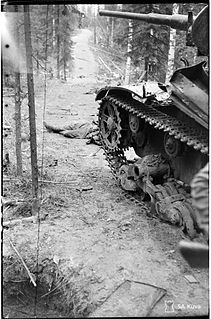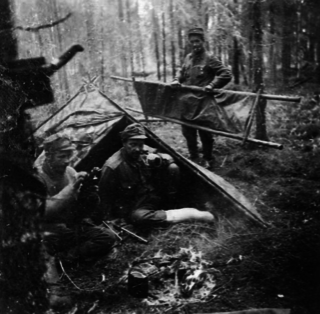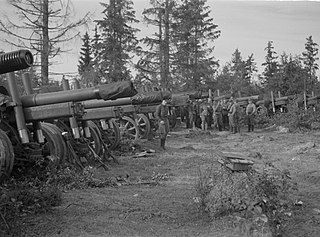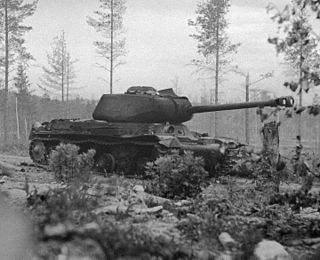 W
WOperation Arctic Fox was the codename given to a World War II campaign by German and Finnish forces against Soviet Northern Front defenses at Salla, Finland in July 1941. The operation was part of the larger Operation Silver Fox which aimed to capture the vital port of Murmansk. Arctic Fox was conducted in parallel to Operation Platinum Fox in the far north of Lappland. The principal goal of Operation Arctic Fox was to capture the town of Salla and then to advance in the direction of Kandalaksha to block the railway route to Murmansk.
 W
WThe Battle of Bengtskär was an amphibious landing action fought between Finnish and Soviet forces on 26 July 1941 during the Continuation War.
 W
WThe Finnish invasion of East Karelia was a military campaign in 1941. It was part of the Continuation War. Finnish troops occupied East Karelia and held it until 1944. For over a month after the outbreak of the Continuation War, the Karelian Army reinforced and prepared to resume its earlier offensive while waiting for the recapture of the Karelian Isthmus. The Soviets had prepared fortifications and brought troops to the front. When encirclements on the western shore of Lake Ladoga were resolved, the Finnish 7th Division was transferred to the junction of VI and VII Corps.
 W
WThe Battle of Hanko was a lengthy series of small battles fought on Hanko Peninsula during the Continuation War between Finland and the Soviet Union in the second half of 1941. As both sides were eager to avoid a major, costly ground battle, fighting took the form of trench warfare, with artillery exchanges, sniping, patrol clashes, and small amphibious operations performed in the surrounding archipelago. A volunteer Swedish battalion served with Finnish forces in the siege. The last Soviet troops left the peninsula in December 1941.
 W
WThe Battle of Ilomantsi was a part of the Svir–Petrozavodsk Offensive of the Continuation War (1941–1944). It was fought from July 26 to August 13, 1944, between Finland and the Soviet Union in an area roughly 40 kilometers wide and 30 kilometers deep, near the Finnish-Soviet border, close to the small Finnish town of Ilomantsi, in North Karelia. The battle ended with a Finnish victory—the last major Soviet attack against Finland was stopped here.
 W
WOperation EF (1941), also the Raid on Kirkenes and Petsamo took place on 30 July 1941, during the Second World War. After the beginning of Operation Barbarossa, the German invasion of the Soviet Union on 22 June 1941, Fleet Air Arm aircraft flew from the aircraft carriers HMS Victorious and Furious to attack merchant vessels in the northern Norwegian port of Kirkenes and the north Finnish port of Liinakhamari in Petsamo.
 W
WNaval Detachment K was a Finnish military detachment—specifically, a flotilla that operated on Lake Ladoga during World War II.
 W
WThe Battle of Nietjärvi was part of the Continuation War between Finland and the Soviet Union, which occurred during World War II. The battle ended in a Finnish victory.
 W
WOperation Hokki was conducted by Finland between 31 July 1944 to 31 August 1944 during the Continuation War. The mission's objective was to destroy the railway yards of Petrozavodsk in order to prevent the enemy from supplying its troops in the Battle of Ilomantsi. Due to the many setbacks that occurred, the objective of the mission was changed and the Finnish troops ended up destroying a large portion of railroad tracks that were being used to supply the Soviet troops in Ilomantsi. Operation Hokki is the only known Finnish airborne operation during World War II and was the largest landing operation in Finnish history.
 W
WThe Battle of Porlampi, also known as the Battle of Porlammi, was a military engagement fought between the Finnish Army and Red Army from 30 August to 1 September 1941 on the Karelian Isthmus. The battle was fought near the town of Porlampi during the second month of the Continuation War. The battle was a Finnish victory and effectively ended the reconquest of Karelia.
 W
WOperation Silver Fox from 29 June to 17 November 1941, was a German–Finnish military operation on the Eastern Front of World War II against the Soviet Union. The objective of the offensive was to cut off and capture the key Soviet Port of Murmansk through attacks from Finnish and Norwegian territory.
 W
WThe Battle of Someri was a battle in the Gulf of Finland during World War II on 8–9 July 1942, between the Soviet Union and Finland. Starting as a modest operation to clear a Finnish observation post from a small island, it became one of the largest surface ship engagements in the Baltic theater.
 W
WThe Battle of Suursaari was fought over the frozen Gulf of Finland on and around the islands of Gogland and Bolshoy Tyuters during the Second World War. After sharp fighting the numerically superior Finnish forces liberated Gogland and Bolshoy Tyuters, and later provided support for German forces defending Bolshoy Tyuters against Soviet counterattacks.
 W
WThe Battle of Tali-Ihantala was part of the Finnish-Soviet Continuation War (1941–1944), which occurred during World War II. The battle was fought between Finnish forces—using war materiel provided by Germany—and Soviet forces. To date, it is the largest battle in the history of the Nordic countries.
 W
WThe Battle of Tienhaara was a part of Continuation War between Finland and the Soviet Union fought north of Viipuri on June 22, 1944, after the Red Army had captured Viipuri. Having lost Viipuri Finns concentrated their defense to the Tienhaara region which offered favourable area for defense with nearby waterway cutting the already narrow battlefield into several islands.
 W
WThe Battle of Vuosalmi – the main bulk of it – lasted from July 4 to July 17, 1944. It was fought during the Continuation War (1941–1944), a part of World War II, between Finland and the Soviet Union.
 W
WThe Battle of Vyborg Bay was fought in the Finnish-Soviet Continuation War (1941–1944).
 W
WThe Vyborg–Petrozavodsk Offensive or Karelian offensive was a strategic operation by the Soviet Leningrad and Karelian Fronts against Finland on the Karelian Isthmus and East Karelia fronts of the Continuation War, on the Eastern Front of World War II. The Soviet forces captured East Karelia and Viborg/Viipuri. After that, however, the fighting reached a stalemate.